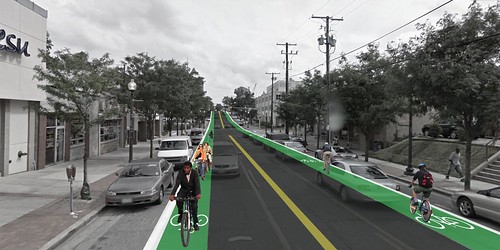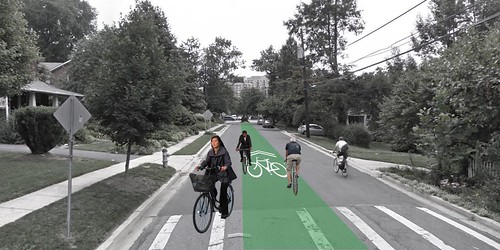UPDATE: Wayne Phyillaier has an excellent write-up on yesterday's Planning Board meeting and some of the other issues surrounding the Bethesda Tunnel.
Yesterday, the Planning Board voted to move the Bethesda Purple Line station out of a tunnel beneath Wisconsin Avenue rather than run the Capital Crescent Trail on the street, which I wrote about yesterday. Their decision isn't binding - it's just a recommendation to the Maryland Transit Administration, which is planning the Purple Line.- but it's awfully shortsighted (The Planning Board "send a very clear message that it will make the alternate trail surface route a priority, especially if the trail is removed from the tunnel," writes Wayne Phyillaier, which is good news.) Not only would moving the Purple Line stop inconvenience people taking the train, but it ignores the real possibilities of creating an on-street biking network that's just as good as one in a tunnel.
Anyway, I whipped up a few Photoshop renderings for yesterday's post to show what an on-street trail might look like in downtown Bethesda, but here a few more I did of Silver Spring:

Bike lanes along Fenton Street at Easley Street in downtown Silver Spring.

Bike lanes replace parking along Second Avenue at Cameron Street.

A few blocks north in Woodside, the bike lane becomes a "sharrow," which denote streets where cars are meant to share the space with bikes. This is one of the tools that Portland uses to turn residential streets like this stretch of Second Avenue into "bike boulevards," in which bikes are given priority.
On GGW, Shane Farthing from the Washington Area Bicyclist Association argued that creating a safe biking experience takes a lot more than the green stripes I showed. And he's right. Just striping a bike lane doesn't mean it'll get used, nor does it mean that drivers will respect it. It takes a lot more, like physically separated lanes, planting areas, and even different paving materials to show that this space belongs to bicyclists, not drivers.
I've always felt that bicycling is an important part of the urban realm, but it wasn't until I actually took up bicycling when I moved to Philadelphia last year that I realized how fun and convenient it is. I'd like to think I could move back to Montgomery County and keep it up, but the infrastructure just isn't there. I'm glad MoCo is exploring bikeshare in Rockville and now in Bethesda and Silver Spring, but I'm not sure how many people will use without a real network of bike routes. Biking isn't for everyone, but unless we make it a safe and practical form of transportation, it won't be for anyone at all.
Even if bicyclists get to use a tunnel for a couple of blocks under downtown Bethesda.
Yesterday, the Planning Board voted to move the Bethesda Purple Line station out of a tunnel beneath Wisconsin Avenue rather than run the Capital Crescent Trail on the street, which I wrote about yesterday. Their decision isn't binding - it's just a recommendation to the Maryland Transit Administration, which is planning the Purple Line.
Anyway, I whipped up a few Photoshop renderings for yesterday's post to show what an on-street trail might look like in downtown Bethesda, but here a few more I did of Silver Spring:

Bike lanes along Fenton Street at Easley Street in downtown Silver Spring.

Bike lanes replace parking along Second Avenue at Cameron Street.

A few blocks north in Woodside, the bike lane becomes a "sharrow," which denote streets where cars are meant to share the space with bikes. This is one of the tools that Portland uses to turn residential streets like this stretch of Second Avenue into "bike boulevards," in which bikes are given priority.
On GGW, Shane Farthing from the Washington Area Bicyclist Association argued that creating a safe biking experience takes a lot more than the green stripes I showed. And he's right. Just striping a bike lane doesn't mean it'll get used, nor does it mean that drivers will respect it. It takes a lot more, like physically separated lanes, planting areas, and even different paving materials to show that this space belongs to bicyclists, not drivers.
I've always felt that bicycling is an important part of the urban realm, but it wasn't until I actually took up bicycling when I moved to Philadelphia last year that I realized how fun and convenient it is. I'd like to think I could move back to Montgomery County and keep it up, but the infrastructure just isn't there. I'm glad MoCo is exploring bikeshare in Rockville and now in Bethesda and Silver Spring, but I'm not sure how many people will use without a real network of bike routes. Biking isn't for everyone, but unless we make it a safe and practical form of transportation, it won't be for anyone at all.
Even if bicyclists get to use a tunnel for a couple of blocks under downtown Bethesda.

9 comments:
Interesting concept. Unfortunately, in a lot of our older neighborhoods the streets are simply too narrow to craft a designated bike lane unless you eliminate on-street parking, which is Ok by me in commercial areas, but a little unfair to homeowners. And what about buses? That section of 2nd Avenue has bus stops where you are putting the bike lane.
I like the concept as well, but Fenton is barely wide enough as-is for 2 lanes of traffic and parking.
It is interesting, however, to envision Fenton as a one-way only street from Wayne Ave. to Rt. 410. It would discourage rush-hour jams on Fenton from folks trying to get off of Georgia Ave, and would also widen the lane, allow for a bike lane, and more parking space.
@Matt
Fenton Street between 410 and Wayne Avenue has two lanes for parking, two through lanes, and a turning lane. My thinking was you could take out the turning lane and replace it with two bike lanes, one in each direction. I'm a little concerned they might be a little narrow, however.
North of Wayne, Fenton Street is four lanes wide. I wouldn't mind taking out parking altogether (there's two parking garages and the Whole Foods parking lot, along with on-street parking on Ellsworth) and replacing it with bike lanes. Or maybe a cycle track like the one the Planning Board proposes on Bethesda Avenue.
@Woody
I think if off-street parking is available, you can take on on-street parking. I know that not every house on Second Avenue has its own driveway or garage (I looked at them when I was making my drawings), which definitely has to be taken into consideration.
Bikes and buses don't always get along (here in Philadelphia, the buses actually stop in the bike lane; I've gotten off the bus and walked into bicyclists before), but one solution might be to create a little island at the bus stops where people can get off and wait safely before crossing the bike lane.
I just do not understand why it is ok to destroy, parkland, homes, streams, and create congestion in Silver Spring-with the Purple Line bu tit is not ok to destroy the same in Bethesda.
Take a walk along the path of the Purple Line in Silver Spring and get a look see at what will be destroyed- it just does not make any sense.
Bob Fustero
Bob, what parkland, homes and streams are being taken out for the Purple Line in Silver Spring? Even along Wayne Avenue, where the street will be widened to accommodate the line (personally, I think you could swap out the trains for the on-street parking and not widen the street, but that's just me), not a single house will be torn down.
Sharrows were just painted on Forest Glen Road near my house when the state repaved the road about a month ago. It's a nice acknowledgement for the dozens of bike commuters in the area, finally. The road definitely isn't wide enough for dedicated lanes, but this is the best alternate solution.
Nice graphics.
Unfortunately, the bike lanes you show along Fenton Street at Easley Street in downtown Silver Spring are all in the door zone of parked cars. Door zone bike lanes have been shown to be much more dangerous than cycling in the traffic lane on an unmarked street. Novice cyclists tend to be lulled into a false sense of security on such lanes - to such an extent that the League of American Bicyclists' Smart Cycling course advises cyclists to avoid such facilities. This is not possible in MD, as current MD law makes bike lane use mandatory where such a lane exists. In order for a bike lane to be viable, it has to have at least a 4ft gap between parked cars and the lane - clearly that could not happen on Fenton Street - there's just not enough room.
The bike lanes you show along Second Avenue at Cameron Street would need underpasses or overpasses at every junction in order to be safer than an unmarked street. This would make such a facility very expensive. Without such over/underpasses, studies show an increase in collisions of between 10 and 15% when such infrastructure is implemented.
Sharrows and bike boulevards are always best. But they have the drawback that drivers tend to think that cyclists are required to use such streets. In MD, which is one of 22 states with the most restrictive cycling laws in the nation ('mandatory bike lane use' and a 'far to the right' law) and a driving population to match, this could become a real problem.
"I'd like to think I could move back to Montgomery County and keep it up, but the infrastructure just isn't there."
Well, that depends on what you call infrastructure. I commute with my 8 year-old daughter from school every weekday - at some point we cycle on 16th Street, which is a 6-lane highway and perfectly safe for cycling as long as we cycle confidently, visibly and predictably by taking our proper place in the roadway. Infrastructure all depends on your point of view, and in my view, MD has 30,000 miles of cycling infrastructure. Fear of the roadway keeps a lot of cyclists off the infrastructure that we cyclists lobbied in the 1890s to have built - this is a great pity, as if we fear using it, and if we don't use it enough to be confident and competent on it, drivers might lobby the government to ban us from using it altogether.
What you are showing in your pictures are painting lanes that are also open to cars... is this a novel approach or do all places only do painted lanes if there is enough space for a dedicated car lane as well?
Post a Comment